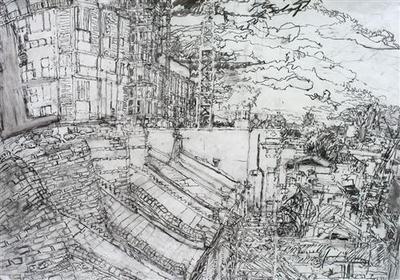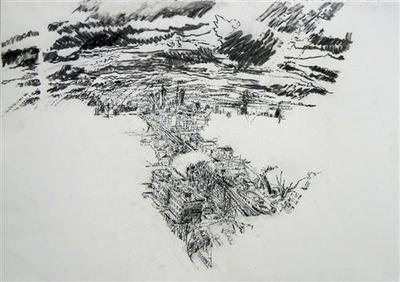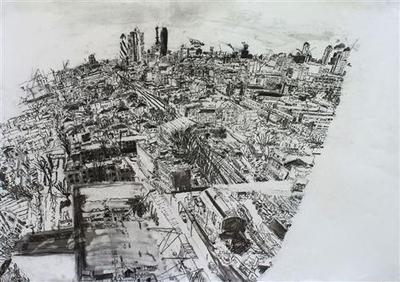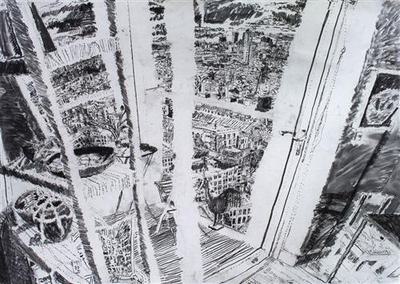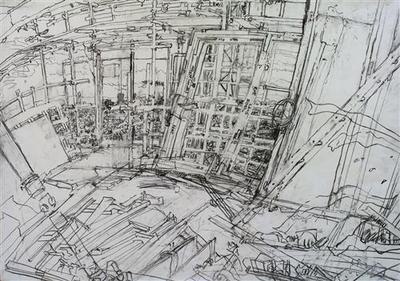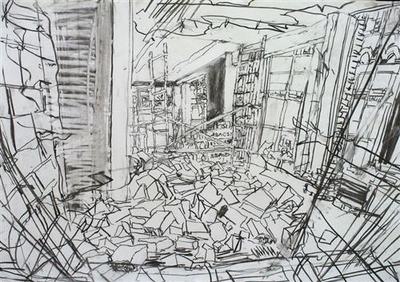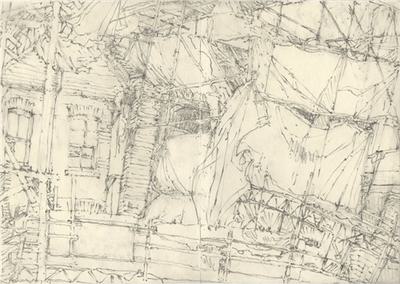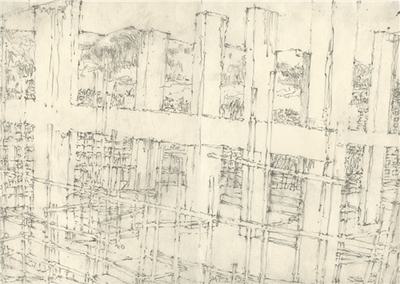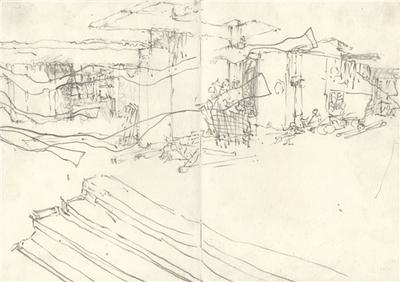Alexandra Blum
London
200 drawings chart the transformation of Dalston, London. The area's innards have been laid bare, dissected layer by layer. I have spent 3 years drawing the upheaval, from the street, within the vast Dalston Square construction site as artist in residence, and now from within one of the completed flats, a home on the 17th floor.
I live locally, but the arrival of 5 huge cranes signalled massive change to a once familiar area. I wanted to explore this transformation taking place right on my doorstep. To explore not just the beginning and end points, but the process of change itself: the rawness, sensitivity to spatial experience and vitality of the transitory spaces which existed during the construction period.
Navigating the building site to draw became a fantastically disorienting process: a previously accessible space suddenly blocked with impenetrable breeze block, doors 200 metres up opened out directly onto the city, scaffolding manifested new spaces, apparently from thin air, ladders scaled vast heights, a solitary figure could battle with the elements balanced on a precipice, then retreat into an increasingly contained space.
An entirely new series of spaces began to materialise: the interior of the construction site running at a different time scale to the rest of the city, as if revealing a condensed version of the life cycle of spaces which evolves over a longer time span throughout the city as a whole.
Now, drawing within a home (one of the completed flats on the 17th floor) time I spent within this very space during its raw building site phase, collides with its present state as a domestic, increasingly personal, space. Structural elements evident in both phases seem to have literally travelled through time, their current pristine veneer reiterating the fragility of domesticity, as if it is only possible to take fleeting ownership of a space made temporarily accessible and habitable, before it reverts, once again, to pure space.
Time itself has become a structural force, visible both through the rapid transformation of space during the evolution of the building and within the surface of each drawing.
Drawing on location has become a catalyst for my own observations and other peoples, and whilst drawing, I have recorded the interaction I've had with passersby and construction workers, along with new and existing residents. Extracts from these interactions create a parallel narrative:
8.4.09 - Boleyn Road:
Blazing sun, in a side street, drawing the gap, once a row of independent high street shops and flats, now making way for the train line, in the interim revealing crumbling Georgian terraces and an expanse of pure space. After a few hours a lady with a bun comments that I'm still there, and marvels at how beautiful the development will be when it's finished, along with the new rose garden that will apparently cover the whole of the road we were standing in. She felt however, this would encourage hobos. Opposite us, she explained, the building used to be a hat factory, was now residential, but for people who paid neither rent nor council tax. This was to be demolished and transformed.
17.12.09 - on site, exterior space between block B and the library:
'You need thermals. If I'd the time I'd stand here with a board behind ya! I'm 70 next birthday, I've got bionic hips, a machine in here (taps his heart). Sometimes I feel alright, but other times...then I think maybe I'll retire. But then I go home and get nagged and change me mind. Ha ha!'
9.9.10 - 17th floor, The Collins' flat:
Ben Collins: 'Before we moved in, a site manager noticed scratches on the window. Each one had to be replaced, each one carried down, it took three men an hour per sheet, they're incredibly heavy. Efficient though, it's really warm up here...Shall I leave my bag there? Will there be any foreground?'
27.1.11 - 18th floor - The Collins' flat:
Looking south, from the bedroom window - sun streaming in, so that I'm in shirt sleeves despite sub zero temperatures outside - it's the in between spaces, the backs of buildings, the decaying plots between one enterprise and another, that are holding the city together, shaping its character and form.
Become a member
We support our members with: insurance, networks, space, opportunities, R&D awards, profiling, advice and mentoring.
Become a member
